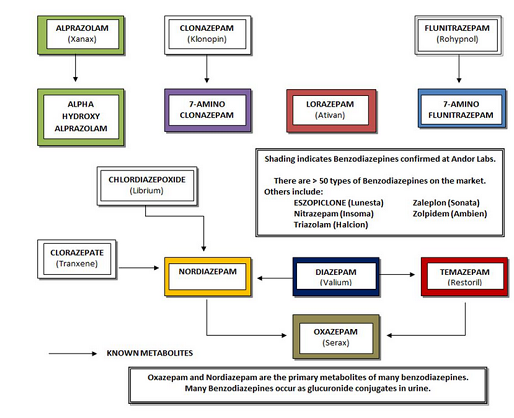|
|
|
Anesthesia Pharmacology: Anxiolytics and Sedative-Hypnotics
Metabolism:
 |
|
Diazepam (Valium)
Alprazolam (Xanax)
Chlordiazepoxide (Librium)
Clonazepam (Klonopin)
Clonazepam is used:
(a) in seizure disorders: absence seizures, myoclonic seizures in children and
(b) as adjunctive treatment in acute mania and in (c) certain movement disorders.
![]() Adverse Effects:
Adverse Effects:
Common: Drowsiness, lethargy
Less common: Muscular incoordination, ataxia
Other: hypotonia, dysarthria, dizziness, behavior disturbances including hyperactivity, irritability, difficulty in concentration.
Seizures may occur if drug is discontinued abruptly.
Flurazepam (Dalmane)
Flurzepam has been prescribed for insomnia.
Flurazepam has long-acting metabolites.
Adverse Effects:
Presence of long-acting metabolites may cause daytime sedation, which may be undesirable.
Triazolam (Halcion)
Triazolam is used to induce sleep.
Triazolam is short-acting with no active metabolites
Adverse Effects: Tolerance may develop and rebound insomnia has been reported.
Reported associations of triazolam with psychotic reactions, dependency, anterograde amnesia are some factors that contributed to triazolam removal from the market in some European countries.5
![]() Flumazenil (Romazicon, benzodiazepine antagonist*)
Flumazenil (Romazicon, benzodiazepine antagonist*)
Primary use is for management of benzodiazepine overdosage.
Additional use in the reduction of benzodiazepine effects in general anesthesia or diagnostic procedures.Competitively antagonizes the binding and allosteric effects of benzodiazepines.
Benzodiazepine-induced electrophysiological and behavioral effects are antagonized.
Fumazenil is available only for intravenous administration (because of high first-pass effect)
![]() Adverse Effects:
Adverse Effects:
In comatose patients, intoxicated with alcohol, flumazenil may increase risk of seizures.
In comatose patients due to tricyclic antidepressant agents, flumazenil increases seizure risk.
[[Hobbs, W.R, Rall, T.W., and Verdoorn, T.A., Hypnotics and Sedatives: Ethanol In, Goodman and Gillman's The Pharmacologial Basis of Therapeutics,(Hardman, J.G, Limbird, L.E, Molinoff, P.B., Ruddon, R.W, and Gilman, A.G.,eds) The McGraw-Hill Companies, Inc.,1996, pp. 372-373.;
McNamara, J.O. Drugs Effective in the Therapy of the Epilepsies, In, Goodman and Gillman's The Pharmacologial Basis of Therapeutics,(Hardman, J.G, Limbird, L.E, Molinoff, P.B., Ruddon, R.W, and Gilman, A.G.,eds) The McGraw-Hill Companies, Inc.,1996, pp. 479];
Dopheide, J.A.. Sleep Disorders, In, Applied Therapeutics: The Clinical Use of Drugs, (Young, L.Y. and Koda-Kimble, M.A.,eds) Applied Therapeutics, Inc., 1995, p 74-5);
[Harvery, R.A, Champe, P.C., Mycek, M.J., Gertner, S.B. and Perper, M.M., Anxiolytic and Hypnotic Drugs, In: Lippincott's Illustrated Reviews: Pharmacology, J.B. Lippincott Co, 1992, p 94]
Eisendrath SJ and Lichtmacher JE "Psychiatric Disorders" in 2008 Current Medical Diagnosis and Treatment, (McPhee SJ, Papadakis MA and Tierney LM, eds) Lange 2008, McGraw Hill Medical, New York, 47th edition, 2008.
Benzodiazepines: Effects on Organ Systems and Side Effects
Cardiovascular System
Except in overdosage, cardiovascular effects of benzodiazepines in normal subjects are minor.
If used as preanesthetic medication, all benzodiazepines decrease blood pressure and increase heart rate.
In this setting diazepam increases coronary flow (perhaps by increasing adenosine concentration).
Respiratory System
At pharmacological hypnotic doses, benzodiazepines do not affect respiration in normal subjects.
At higher doses, such as those used for endoscopy or when given as preanesthetic medication, benzodiazepines somewhat depress alveolar ventilation due to a decrease in hypoxic drive. (as noted above)
These effects are worse in patients with COPD (chronic obstructive pulmonary disease).
In the presence of other CNS depressant drugs, severely benzodiazepine intoxicated patients may require assisted respiration.
![]() If a patient, however, has a sleep-related breathing syndrome such
as obstructive sleep apnea (OSA), benzodiazepines may be
contraindicated.
If a patient, however, has a sleep-related breathing syndrome such
as obstructive sleep apnea (OSA), benzodiazepines may be
contraindicated.
In this setting benzodiazepines may decrease muscle tone in the upper airway and accentuate the effect of apneic episodes on:
Alveolar hypoxia
Pulmonary hypertension
Cardiac demand
Central Nervous System
With increasing doses, benzodiazpines can progressive cause sedation, then hypnosis and then stupor.
Since awareness persists, benzodiazepines do not cause general anesthesia
Anti-anxiety / sedative-hypnotic properties
Some benzodiazepines are effective muscle relaxants (clonazepam (Klonopin)) , whereas most others ( diazepam (Valium)) are not.
Other Agents--further comments about buspirone
Buspirone is a non-benzodiazepine anxiolytic drug.
Site of action: 5-HT1A receptor subtype.
No anticonvulsant activity.
No interaction with benzodiazepine binding sites
No influence on interaction of GABA with the GABA receptor.
Not effective in management of severe anxiety/panic disorder.
No cross-tolerance with other sedative-hypnotic drugs
No muscle relaxant properties.
Minimal adverse effects
Hibbs, W.R, Rall, T.W., and Verdoorn, T.A., Hypnotics and Sedatives; Ethanol In, Goodman and Gillman's The Pharmacologial Basis of Therapeutics,(Hardman, J.G, Limbird, L.E, Molinoff, P.B., Ruddon, R.W, and Gilman, A.G.,eds) TheMcGraw-Hill Companies, Inc.,1996, pp. 364-367.
Baldessarini, R. J., Drugs and the Treatment of Psychiatric Disorders, In, Goodman and Gillman's The Pharmacologial Basis of Therapeutics,(Hardman, J.G, Limbird, L.E, Molinoff, P.B., Ruddon, R.W, and Gilman, A.G.,eds) TheMcGraw-Hill Companies, Inc.,1996, pp. 425]
Anxiolytic-Sedative Hypnotic Drug List
Alprazolam (Xanax)j
Clonazepam (Klonopin)
Diazepam (Valium)
Lorazepam (Ativan)
Triazolam (Halcion)
Flumazenil* (Romazicon) *receptor antagonist
Non-Depressant Anxiolytic
Buspirone (BuSpar)
Treatment of alcoholism
Disulfiram
Barbiturates/Anesthetics
Pentobarbital (Nembutal)
Phenobarbital (Luminal)
Thiopental (Pentothal)
DISCLAIMER
|